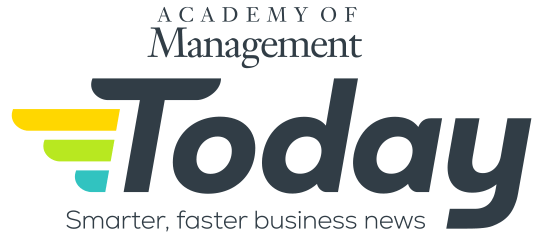Published on: April 2, 2025
By Daniel Butcher
Current business leaders aren’t only tasked with maximizing shareholder value; they must balance competing priorities, including setting and meeting environmental, social, and governance objectives. Long-term organizational sustainability requires maintaining profitability while maximizing the organization’s positive social and environmental impact and minimizing negative effects. Navigating these tensions entails overcoming various leadership challenges.
For example, Academy of Management Scholar Wendy Smith of the University of Delaware said that Paul Polman, the former CEO of British-Dutch consumer packaged goods company Unilever, is remembered for establishing the company’s Sustainable Living Plan, which had a set of goals committed to health and well-being, enhanced livelihoods, the environment, social value.
“Polman pulled Unilever out of a death spiral and set it on the path of being the top packaged goods company,” Smith said. “Importantly, he doubled profits and ensured success not in spite of, but rather because of a commitment to addressing environmental and societal demands.
“In an interview we conducted with Polman, he noted that tensions between profits and social missions emerged all the time,” she said.
Unilever’s leadership grappled with questions such as whether to create consumer packaged goods products that were in bigger containers to minimize plastic and waste or smaller containers to increase the margins on each item sold. For Unilever, that question introduced an innovation opportunity: Could they rethink packaging to enable them to sell goods with less environmental impact?
“These kinds of tensions come up all the time,” Smith said. “Effective leadership depends on evaluating these tensions and applying a more holistic both/and approach to come up with more effective solutions.
“Doing so depends on building leadership competencies for both/and thinking, where teams can have difficult conversations that value and engage opposing perspectives and seek new insights,” she said.
-
Daniel Butcher is a writer and the Managing Editor of AOM Today at the Academy of Management (AOM). Previously, he was a writer and the Finance Editor for Strategic Finance magazine and Management Accounting Quarterly, a scholarly journal, at the Institute of Management Accountants (IMA). Prior to that, he worked as a writer/editor at The Financial Times, including daily FT sister publications Ignites and FundFire, as well as Crain Communications’s InvestmentNews and Crain’s Wealth, eFinancialCareers, and Arizent’s Financial Planning, Re:Invent|Wealth, On Wall Street, Bank Investment Consultant, and Money Management Executive. He earned his bachelor’s degree from the University of Colorado Boulder and his master’s degree from New York University. You can reach him at dbutcher@aom.org or via LinkedIn.
View all posts
Up next....
Everyone Will Suffer in the Wake of Trump Administration’s Research Cuts
Source: Shutterstock
By Paul Friedman
This year, the Trump administration has fired many government researchers, canceled scientific and medical research grants, and targeted leading universities, including Harvard, with debilitating funding freezes. Fear of reprisal has caused many scientists, doctors, professors, and university administrators to opt for silence instead of speaking up to defend the research that is getting the ax.
Academy of Management (AOM) Scholar Peter Bamberger of Tel Aviv University says much of the research produced by him and his colleagues, including many AOM members, has a day-to-day impact on industry practitioners, including organizational leaders and managers. Cuts in federal funding for research will have a negative impact on industry, as well as researchers, colleges and universities, and other research institutions.
“What we publish in our primary journals have to be both theoretically important and have practical relevance,” Bamberger said. “It’s got to be interesting from a theoretical perspective and intellectual perspective, and it’s got to have some sort of surprising element—going against conventional wisdom—but it also has to translate that surprising finding into something that managers can do something about.
“And there are thousands of organizational consultants who read the findings published in our journals and then translate that into actual practice in organizations,” he said.
Bamberger points out that a great deal of research is specifically aimed at examining current practices by managers and their efficacy. Recently, he published a study of the managerial approach called design thinking, which focuses on understanding clients’ needs and designing innovative solutions.
“Design thinking has been around for about 10 years,” Bamberger said. “It’s an approach to create more innovative ways of boosting learning and finding innovative solutions to common problems or sometimes even really wicked problems.
“It became a fad and a lot of organizations adopted it, but no one ever bothered to actually assess whether or not it has an impact and whether this impact is any greater than other types of learning-oriented interventions, like team building,” he said.
Bamberger and research colleagues designed a field experiment to test the impact of design thinking as a team learning intervention. They compared over time what happens in terms of the efficiency and productivity of teams using different interventions.
“Is design thinking more efficacious than an alternative?” Bamberger said. “And we found out that in fact it is, and we actually demonstrate the mechanism by which it operates and why it’s more effective than other mechanisms.
“So these types of practical implications are useful to managers and to the extent that we don’t have funding necessary to do this type of research, everybody suffers,” he said.
-
Paul Friedman is a journalist who worked for 45 years at the three major news networks. He began as a writer and reporter and then became a producer of major news broadcasts, including Nightly News and the Today show at NBC, and World News Tonight with Peter Jennings at ABC. He also served as Executive VicePresident of News at ABC and CBS. Later, he taught journalism as a professor at Columbia University, New York University, and Quinnipiac University. Friedman is now semi-retired and lives with his wife in Florida.
View all posts
Up next....
“Just Add a Woman and Stir” Is Not Enough for Board Success
By Daniel Butcher
Even at organizations that have made strides in adding women and people of color to their governing boards, tokenism is all too common. Diverse board members can’t make a difference if their longer-tenured colleagues routinely disregard their suggestions.
Academy of Management Scholar Kris Byron of Georgia State University said that female board members and those representing an ethnic or racial minority are often sidelined, technically part of the board but to whom the other directors or trustees don’t really listen.
Byron and research colleague Corinne Post of Villanova published an article on this topic in Academy of Management Journal.
“There’s this idea that you just add women and stir and that’s enough, but that’s not enough,” Byron said. “If we’re saying that the ways in which a woman might add value is that she might have different perspectives or a different lens through which to look at an issue, or she might have information or knowledge or experience that maybe some of her male colleagues don’t have.
“That knowledge, experience, and perspectives mean nothing—they’re not going to have any effect—if people aren’t willing to acknowledge the usefulness of that perspective or knowledge or experience,” she said. “There’s probably lots of other things that are important to whether or not the woman on the board is a token, or whether or not there’s some kind of critical mass of female directors on the board.
“Do people think, ‘Oh, she’s just there on the board because we had to fill this quota—she wasn’t the best person to serve in this role; she’s just here for window dressing to make us look good.’”
Diversity is hollow if it isn’t accompanied by equity, inclusion, and fostering a sense of belonging among members of marginalized and minority groups. Actually listening to female board members’ ideas and suggestions and enacting the best of them are crucial for them to have a chance to improve an organization’s leadership.
“There has to be this real belief among the other board directors that these women, that all of the directors, have some value-add, and that isn’t a given,” Byron said. “So that’s what it means that you can’t just add women and stir.
“There has to be some other things that are in place in order for women to have a positive impact on an organization, especially on something that’s so distal or downstream like firm performance,” she said. “Board directors largely have an indirect effect on organizational performance.”
-
Daniel Butcher is a writer and the Managing Editor of AOM Today at the Academy of Management (AOM). Previously, he was a writer and the Finance Editor for Strategic Finance magazine and Management Accounting Quarterly, a scholarly journal, at the Institute of Management Accountants (IMA). Prior to that, he worked as a writer/editor at The Financial Times, including daily FT sister publications Ignites and FundFire, as well as Crain Communications’s InvestmentNews and Crain’s Wealth, eFinancialCareers, and Arizent’s Financial Planning, Re:Invent|Wealth, On Wall Street, Bank Investment Consultant, and Money Management Executive. He earned his bachelor’s degree from the University of Colorado Boulder and his master’s degree from New York University. You can reach him at dbutcher@aom.org or via LinkedIn.
View all posts
Up next....
What Are the Effects of Adding Women to Boards? It’s Complicated.
By Daniel Butcher
Research shows that companies with more female directors can have better firm performance—and this is especially the case in countries that have stronger shareholder protections or that have greater gender equality. In addition, organizations whose boards have more female directors tend to be more engaged in activities that are central to boards’ responsibilities: monitoring and strategy involvement.
Academy of Management Scholar Kris Byron of Georgia State University said that board monitoring refers to the extent to which boards engage in activities that entail oversight of the firm and seek to control managers. Board strategy involvement refers to the extent to which boards engage in activities related to their advising role and decide how firms should compete in the marketplace.
Byron and research colleague Corinne Post of Villanova published an article on this topic in Academy of Management Journal.
“What we found was that there was a positive effect of adding women to the board on strategic involvement and a positive impact on board monitoring, but that board diversity is neither wholly detrimental nor wholly beneficial to firm financial performance,” Byron said. “There is some research showing that when you have more women on your board, they’re more likely to influence fellow directors’ or trustees’ behavior and that the norms of the board changes, for example, attendance gets better.
“There’s this spillover effect that women might have; maybe they come onto the board and they’re more diligent,” she said. “In some ways, that makes sense, because there aren’t tons of women who are in those kinds of senior positions, and so, if she got to that position, then she is probably quite exceptional and especially conscientious.
“Those behaviors may spill over to her male counterparts on the board, and there is research suggesting that that’s something that probably occurs.”
-
Daniel Butcher is a writer and the Managing Editor of AOM Today at the Academy of Management (AOM). Previously, he was a writer and the Finance Editor for Strategic Finance magazine and Management Accounting Quarterly, a scholarly journal, at the Institute of Management Accountants (IMA). Prior to that, he worked as a writer/editor at The Financial Times, including daily FT sister publications Ignites and FundFire, as well as Crain Communications’s InvestmentNews and Crain’s Wealth, eFinancialCareers, and Arizent’s Financial Planning, Re:Invent|Wealth, On Wall Street, Bank Investment Consultant, and Money Management Executive. He earned his bachelor’s degree from the University of Colorado Boulder and his master’s degree from New York University. You can reach him at dbutcher@aom.org or via LinkedIn.
View all posts
Up next....
Eight Tips for More Effective Generative AI Prompts
Source: Shutterstock
By Daniel Butcher
Academy of Management Scholar Herman Aguinis of the George Washington University School of Business, one of the most influential management professors and researchers, said creating prompts is the key to using ChatGPT and other generative-AI software effectively. When users input prompts that lack specificity and crucial contextual information, generative-AI platforms generate too many, too few, or vague recommendations and results that aren’t useful.
The following guidelines were designed by Aguinis and coauthors Jose Beltran of Rutgers University and Amando Cope of the George Washington University to give leaders tools to improve their ability to write AI prompts and generate more precise, relevant responses:
Source: “How to use generative AI as a human resource management assistant,” Organizational Dynamics, Vol. 53, Issue 1, January–March 2024, https://doi.org/10.1016/j.orgdyn.2024.101029
-
Daniel Butcher is a writer and the Managing Editor of AOM Today at the Academy of Management (AOM). Previously, he was a writer and the Finance Editor for Strategic Finance magazine and Management Accounting Quarterly, a scholarly journal, at the Institute of Management Accountants (IMA). Prior to that, he worked as a writer/editor at The Financial Times, including daily FT sister publications Ignites and FundFire, as well as Crain Communications’s InvestmentNews and Crain’s Wealth, eFinancialCareers, and Arizent’s Financial Planning, Re:Invent|Wealth, On Wall Street, Bank Investment Consultant, and Money Management Executive. He earned his bachelor’s degree from the University of Colorado Boulder and his master’s degree from New York University. You can reach him at dbutcher@aom.org or via LinkedIn.
View all posts
Up next....
What It Takes to Be a Powerful Leader
Source: Shutterstock
By Daniel Butcher
To climb the ladder in your profession and achieve success, hard work is table stakes, not a differentiator. And to progress from rank-and-file employee to manager to respected, powerful leader might require a fundamental mindset shift of letting go of a need to be seen as likeable and authentic while cultivating professional relationships.
Academy of Management Scholar Jeffrey Pfeffer of Stanford University, one of today’s most influential management professors and researchers, offers some takeaways on that subject from his book7 Rules of Power, which isa manual for increasing the ability to get things done and benefitting from job performance.
“Good performance by itself is not necessarily going to bring you the level of career success that you need,” Pfeffer said. “In addition, you need technical and political skills to have your boss recognize your good contributions.
“If you think about management, and leadership is managing through other people, you need to learn how to interact with other people across your organization in ways that build your influence and permit you to get the things done that you want to get done,” he said.
Pfeffer’s seven rules power are:
1. Get out of your own way: “Lose the self-descriptions and inhibitions that hold you back, for example, the idea that you have to be liked, because, as an executive, you’re hired to get things done, not necessarily to win a popularity contest. Lose this currently popular idea that you need to be quote-unquote authentic, which is, of course, incorrect.”
2. Break the rules: “In strategy and organizational leadership, if you do what everybody else does, you will probably not succeed—you need to differentiate yourself.”
3. Show up in powerful fashion: “Body language and how we communicate is obviously important.”
4. Create a powerful brand: “If you’re perceived as a powerful, effective, efficacious leader, then that becomes a self-fulfilling prophecy—good people want to work with you, invest with you, and buy from your company.”
5. Network relentlessly: “That’s something that people often don’t want to do, so they underinvest in networking because they feel dirty about it and don’t see it as the value-adding activity that it is.”
6. Use your power: “Not all use of power will be met with unalloyed approval, so leaders need to be willing to incur some level of social disapproval. But because most people are usually averse to conflict, it is surprising how much one can accomplish by seizing the initiative.”
7. Understand that once you have acquired power, what you did to get it will be forgiven, forgotten, or both: “Once you have power and status and success, no one will care how you got it, and people will people will accommodate themselves, because people like to be close to power.”
Upon reading or hearing about those precepts and their implications for workplace power dynamics, many people have an adverse reaction. That’s natural and understandable, Pfeffer said.
“Every person should understand and come to terms with the seven rules of power, and most will go through stages: first, denial—‘This doesn’t work in my organization’s culture’—then they will have anger, which will mostly be directed at me, which is fine,” he said. “Then they will have sadness—‘I’m depressed by it’—and finally, they often come to acceptance that this is not only the way the world works, but they can build agency around this.
“My biggest contribution is causing them to see their own agency and encouraging them to be more ambitious and more agentic around navigating their own career and getting their boss to recognize their talents, instead of sitting back and waiting for the human resources department to offer promotions and raises.”
-
Daniel Butcher is a writer and the Managing Editor of AOM Today at the Academy of Management (AOM). Previously, he was a writer and the Finance Editor for Strategic Finance magazine and Management Accounting Quarterly, a scholarly journal, at the Institute of Management Accountants (IMA). Prior to that, he worked as a writer/editor at The Financial Times, including daily FT sister publications Ignites and FundFire, as well as Crain Communications’s InvestmentNews and Crain’s Wealth, eFinancialCareers, and Arizent’s Financial Planning, Re:Invent|Wealth, On Wall Street, Bank Investment Consultant, and Money Management Executive. He earned his bachelor’s degree from the University of Colorado Boulder and his master’s degree from New York University. You can reach him at dbutcher@aom.org or via LinkedIn.
View all posts
Up next....
How Organizations Undermine Managers’ Effectiveness
Source: Shutterstock
By Daniel Butcher
Many organizations are guilty of some common missteps when it comes to how they’re handling their managers.
Academy of Management Scholar Carol Kulik of the University of South Australia said that part of the problem is that managers don’t have the chance to practice leadership skills or management strategies and tactics before they have to actually put them into practice leading a team.
“Many line managers don’t get proper training before taking on their role, and as a result, their first thought is the impact of employees’ career-development decisions on themselves; this is a very natural reaction,” Kulik said. “So when an employee comes to you and says, ‘I have this other job opportunity, and I’m going to be leaving,’ it’s hard for line managers in the moment to say, ‘Oh, that does sound like a good opportunity; I’m happy for you,’ because what they’re thinking in their head is, ‘Oh, this really sucks for me, because I’ve made this big investment in onboarding and developing you and now I’m going to have to replace you.’
“Leadership has to train line managers to find the right words at the right time,” she said. “And most organizations don’t make that investment in their line managers. “I know it sounds contradictory, but line managers need to have these scripts available, to be prepared for the unexpected.”
Kulik said that she encourages organizations to look carefully at their line managers.
“I often call them the unsung heroes,” she said. “Organizations have so much hanging on the line managers doing the right thing at the right time in individual interactions with their team members, and I think they’re chronically underappreciated in organizations today.”
A sample of Kulik’s AOM research findings:
-
Daniel Butcher is a writer and the Managing Editor of AOM Today at the Academy of Management (AOM). Previously, he was a writer and the Finance Editor for Strategic Finance magazine and Management Accounting Quarterly, a scholarly journal, at the Institute of Management Accountants (IMA). Prior to that, he worked as a writer/editor at The Financial Times, including daily FT sister publications Ignites and FundFire, as well as Crain Communications’s InvestmentNews and Crain’s Wealth, eFinancialCareers, and Arizent’s Financial Planning, Re:Invent|Wealth, On Wall Street, Bank Investment Consultant, and Money Management Executive. He earned his bachelor’s degree from the University of Colorado Boulder and his master’s degree from New York University. You can reach him at dbutcher@aom.org or via LinkedIn.
View all posts
Up next....
Pay Gaps Undermine Diversity and Inclusion
Source: Shutterstock
By Daniel Butcher
Lack of pay equity can undermine an organization’s efforts to improve diversity and hurt the effectiveness of the leadership team.
Academy of Management Scholar Carol Kulik of the University of South Australia said that her research has found that in organizations that had pay gaps within their executive teams, as organizations added more women to executive teams, the companies’ financial performance actually went down.
“In other words, the firms are shooting themselves in the foot, as they’re trying to have more gender diversity in the senior team, but they simultaneously have this gender inequality in pay,” Kulik said. “They are sending a signal to the leadership team: ‘We’re putting women on the team, but we don’t value them as much,’ so as a result, the team doesn’t operate as effectively as it should.
“The leadership team isn’t able to take advantage of the gender diversity that it has,” she said. “I’m really proud of that research, because we often think about gender pay gaps as being a problem for women, but our research shows that gender pay gaps are a problem for women’s employers, that when they have gender pay gaps at the top, they’re actually making their whole executive team function less effectively.”
Women tend to be paid less than their male counterparts in the same leadership group, regardless of the quality of their respective performance. Kulik and fellow researchers suggest that the voices of these underpaid women exert less influence on the leadership team’s decisions and activities. Unheard and discounted, the women become demotivated and less engaged in the leadership team.
“It’s actually an interaction effect, so it’s not the gap itself that lowers performance; rather, it’s the exacerbating effects of the gap as you add more women to the team,” Kulik said. “So if you have one woman on the team, you’re probably not going to see that drop quite as strongly.
“But the more women you have on the team, the clearer it becomes that this is a function of gender, and not one person having less skills or less experience, the more it becomes clearly a gender gap,” she said. “And so that’s when it becomes a problem for the organization.”
A sample of Kulik’s AOM research findings:
-
Daniel Butcher is a writer and the Managing Editor of AOM Today at the Academy of Management (AOM). Previously, he was a writer and the Finance Editor for Strategic Finance magazine and Management Accounting Quarterly, a scholarly journal, at the Institute of Management Accountants (IMA). Prior to that, he worked as a writer/editor at The Financial Times, including daily FT sister publications Ignites and FundFire, as well as Crain Communications’s InvestmentNews and Crain’s Wealth, eFinancialCareers, and Arizent’s Financial Planning, Re:Invent|Wealth, On Wall Street, Bank Investment Consultant, and Money Management Executive. He earned his bachelor’s degree from the University of Colorado Boulder and his master’s degree from New York University. You can reach him at dbutcher@aom.org or via LinkedIn.
View all posts
Up next....
A Downside of Human Resource Management Devolution
Source: Shutterstock
By Daniel Butcher
Human resource management (HRM) devolution—leadership transferring HRM responsibilities from specialist executives to managers—is becoming more common worldwide. However, there’s debate over whether it helps employees and organizations or adds too much to managers’ already-full plates.
Academy of Management Scholar Carol Kulik of the University of South Australia noted that HRM devolution is controversial.
“We’ve taken all these activities that used to be the responsibility of HR managers and units and put them in the hands of line managers,” Kulik said. “There’s some research that shows that individual employees have on average two important people-management conversations every week.
“They aren’t having those conversations with HR but rather with their line managers,” she said. “You can have the best people-management practices in the world, but it really comes down to how your individual line manager enacts them on a day-to-day basis.”
Kulik emphasized that managers’ jobs have gotten so much harder. Often, they get insufficient training before being promoted. Further, many are now responsible for managing more employees with smaller budgets.
“Even when they have budgets that look large, because they’re spreading it across more employees, they don’t have as many dollars for training or for rewarding top performers,” Kulik said. “And they’re now managing people on hybrid schedules or in remote environments that they never worked in themselves, so the job itself is getting much, much harder.
“There’s evidence right now that people don’t even want to become line managers—they’re saying, ‘I just want to spend my whole career being an individual contributor,’” she said. “So here’s this incredibly important job, and we have line managers who have never received formal training in people management, because they didn’t see that as part of their the primary part of their role.
“And yet, they’re this critical linchpin in an organization.”
A sample of Kulik’s AOM research findings:
-
Daniel Butcher is a writer and the Managing Editor of AOM Today at the Academy of Management (AOM). Previously, he was a writer and the Finance Editor for Strategic Finance magazine and Management Accounting Quarterly, a scholarly journal, at the Institute of Management Accountants (IMA). Prior to that, he worked as a writer/editor at The Financial Times, including daily FT sister publications Ignites and FundFire, as well as Crain Communications’s InvestmentNews and Crain’s Wealth, eFinancialCareers, and Arizent’s Financial Planning, Re:Invent|Wealth, On Wall Street, Bank Investment Consultant, and Money Management Executive. He earned his bachelor’s degree from the University of Colorado Boulder and his master’s degree from New York University. You can reach him at dbutcher@aom.org or via LinkedIn.
View all posts
Up next....
Ongoing Conversations: A Secret to Managers’ Success
Source: Shutterstock
By Daniel Butcher
There’s a simple best practice for managers to increase their effectiveness: having regular conversations with their direct reports and actually listening to what they say.
Academy of Management Scholar Carol Kulik of the University of South Australia said that, based on her own and colleagues’ research, she encourages managers to have ongoing conversations with their employees.
“One of the things that’s happened in organizations is that so many interactions moved to Zoom or Slack, and these are both media where the conversations are very terse; the communication is very brief and short,” Kulik said. “In a Zoom meeting, managers are conscious of not wanting to waste anybody’s time, so they tend to stick with the agenda, and that’s good; that feels very efficient.
“But it means that you may not be having those chance encounters with employees, where you learn about skills they might be interested in developing or challenges that they’re having at a very early stage where it’s not a big enough problem that they’re going bring it to their manager, but it might surface in a conversation,” she said. “So we really need to encourage managers to have the catchups with employees.”
This piece of advice sounds like common sense, but Kulik said that it’s surprising how often it falls off managers’ radar. Many managers get caught up in other tasks and responsibilities and fail to prioritize one-on-one, face-to-face meetings with their team members.
“Line managers will always say that they plan to have catchups with their employees—sure, they scheduled them at the beginning,” Kulik said. “But line managers have these really big jobs; they’re always trying to put out fires.
“The first thing that goes is that catchup; it gets postponed or rolled into another meeting, so employees don’t get the one-on-one interaction with their manager that could be so important for boosting their performance and career development,” she said.
A sample of Kulik’s AOM research findings:
-
Daniel Butcher is a writer and the Managing Editor of AOM Today at the Academy of Management (AOM). Previously, he was a writer and the Finance Editor for Strategic Finance magazine and Management Accounting Quarterly, a scholarly journal, at the Institute of Management Accountants (IMA). Prior to that, he worked as a writer/editor at The Financial Times, including daily FT sister publications Ignites and FundFire, as well as Crain Communications’s InvestmentNews and Crain’s Wealth, eFinancialCareers, and Arizent’s Financial Planning, Re:Invent|Wealth, On Wall Street, Bank Investment Consultant, and Money Management Executive. He earned his bachelor’s degree from the University of Colorado Boulder and his master’s degree from New York University. You can reach him at dbutcher@aom.org or via LinkedIn.
View all posts
Up next....
Managers’ Crucial Role in Onboarding and Retention
Source: Shutterstock
By Daniel Butcher
As a greater number of managers take on more responsibilities that organizations used to assign to human-resources staff, many could benefit from training so that they can improve the experience of candidates and new hires during the interviewing and onboarding processes.
Academy of Management Scholar Carol Kulik of the University of South Australia said that managers make a difference in virtually every stage of an employee’s life, from recruitment, interviewing, and onboarding to day-to-day work and performance management.
“As a result of the COVID pandemic, we moved so much of the recruiting process—interviewing, hiring, and onboarding—online, and we’re never going back because online is cheaper and easier,” Kulik said. “But as a result, employees aren’t getting the kind of onboarding experience that they used to get where they were in a cohort with other new employees and had a chance to ask questions face-to-face.
“So now that’s the responsibility of the line manager, to fill in the gaps to help the new employee form relationships and encourage them to be proactive,” she said. “Nobody’s thinking about how that line manager is going to develop those skills.”
Another example Kulik points to is at the other end of employees’ careers, when they are considering leaving the organization for another opportunity or retiring. Line managers’ actions at this point can make or break an organization’s retention efforts.
“We know from research that the final interaction that you have with your manager, that one event is more important in determining how you feel about the company than anything else that’s happened in your entire career history,” Kulik said. “And yet, line managers aren’t prepared for that moment when an employee says, ‘I’ve got another job opportunity; I’m leaving.’
“Nobody’s taught them how to respond when an employee comes in and says they’re leaving, and we really depend on line managers to make sure that employees leave their jobs with a good attitude toward the company,” she said. “We count on them to be ambassadors or alumni.”
Another example Kulik gives is managers’ role in diversity, equity, and inclusion (DEI). She has conducted research focusing on age and gender and how leaders make workplaces to be inclusive for a wide range of people.
“You can have the best DEI practices in the world, but it’s the individual line manager who has to enact those practices,” Kulik said. “Mature-age employees tell us that they come to their line managers when they need a very small accommodation, for example, changing their shift or changing the size of the packages that they’re loading.
“And they tell us again and again that their line managers aren’t very receptive,” she said. “Line managers are used to treating all the employees exactly the same way.
“There’s a whole range of activities where we can point to the line manager as the key variable.”
A sample of Kulik’s AOM research findings:
-
Daniel Butcher is a writer and the Managing Editor of AOM Today at the Academy of Management (AOM). Previously, he was a writer and the Finance Editor for Strategic Finance magazine and Management Accounting Quarterly, a scholarly journal, at the Institute of Management Accountants (IMA). Prior to that, he worked as a writer/editor at The Financial Times, including daily FT sister publications Ignites and FundFire, as well as Crain Communications’s InvestmentNews and Crain’s Wealth, eFinancialCareers, and Arizent’s Financial Planning, Re:Invent|Wealth, On Wall Street, Bank Investment Consultant, and Money Management Executive. He earned his bachelor’s degree from the University of Colorado Boulder and his master’s degree from New York University. You can reach him at dbutcher@aom.org or via LinkedIn.
View all posts





















